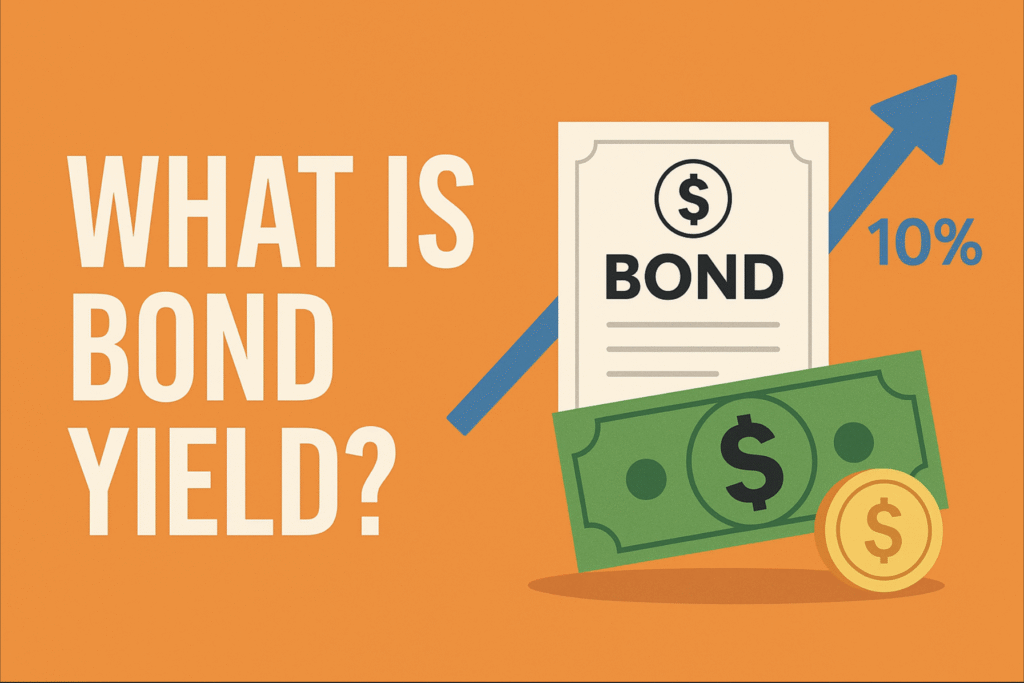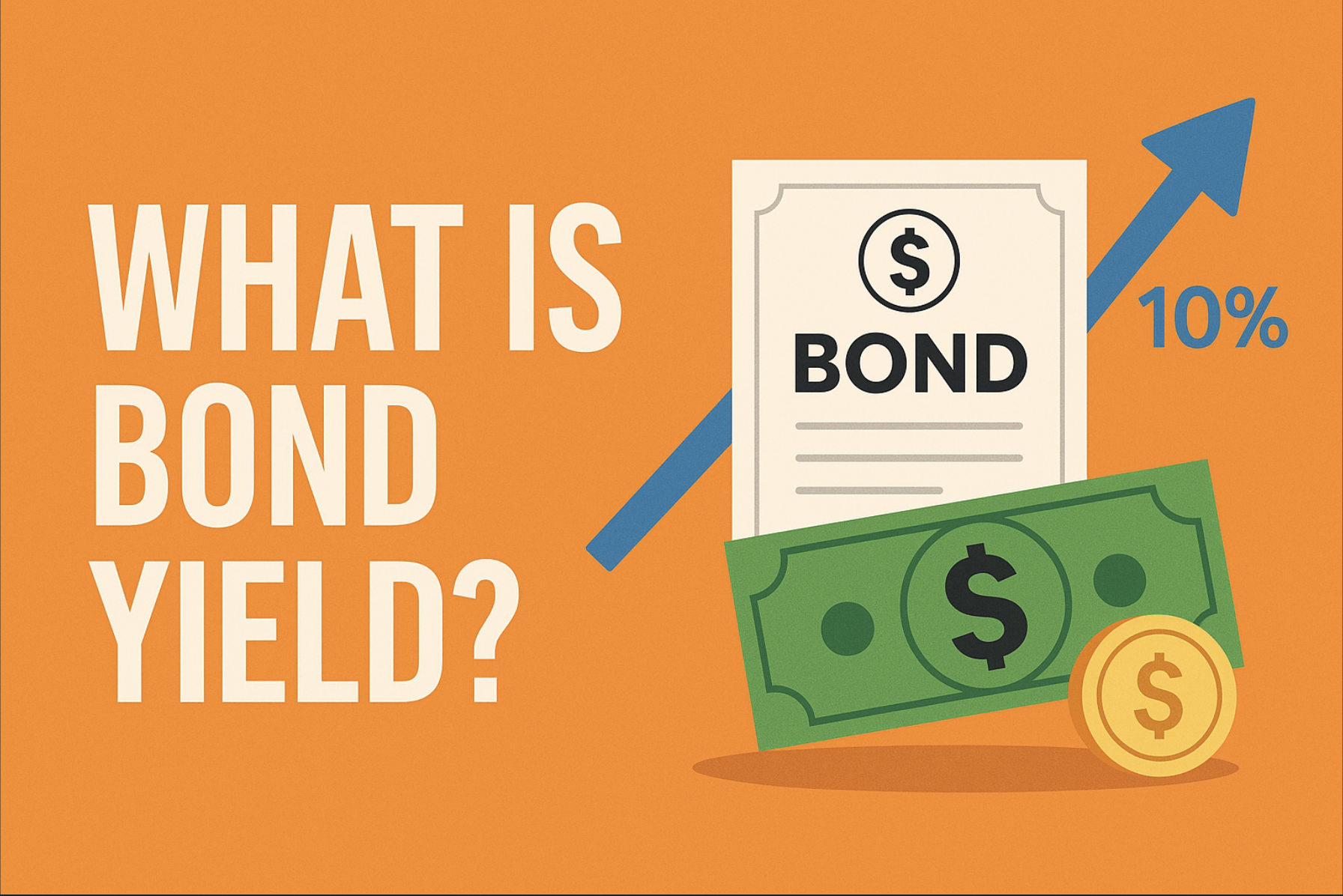A bond yield is return you get by investing your money in bonds, just like interest in savings account . it depends on factors like price, interest payment , taxes or other things. in this blog you will get all about bond yield.

AI GENRATED IMAGE
What is Bond Yield?
Yield means return — like yield on land, yield on an effort, yield on an investment, yield on commodities, etc. When it comes to bonds, yield means the same thing: a return on bonds — how much return you get by investing in bonds. This is the simple and quick explanation about yield. If you still have doubts, then think of it like the interest rate you get by putting money in a savings account. It’s your return on investment for lending your money to a government or company.
How it works
When you buy a bond, you lend money to governments, corporations, and institutions. In return, they promise to pay interest on a regular basis (this is called a coupon). Yield tells you how much return you get on the money you invested.
Example:If you buy a $1,000 bond and they promise to pay a 10% coupon rate, you get $100 every year. This means $100 is 10% of $1,000 — so 10% is your yield.
But:
Interest rates in the market will have a major impact on bonds, and the rate of inflation also affects the prices of bonds. Investors expect higher yields when the interest rate is high, and the same vice versa. Also, the foreign and domestic flow influences the price of bonds — for example, if FDI inflows money into bonds, the prices of bonds go up because of demand, and that’s why the yield of bonds goes down. When you understand what affects bond yields, you must also understand that bond yield is inversely proportional to the price of bonds. If the price of the bond goes up, then the yield goes down, and vice versa.

AI GENERATED IMAGE
Understanding Bond Yield
A bond is an important loan for issuers. A bond is considered one of the safest investments because a bond is not volatile like stocks; their prices don’t change every minute or every hour.
They offer investors a reliable stream of income and provide bondholders with predictability. There are a lot of types of bonds in the market; you can invest your money according to your financial goals.
Investors can earn interest on bonds for a lifetime in perpetual bonds. If not, they can get their money back at maturity in other bonds. Investors can purchase bonds at a discounted value or for a premium value compared to face value (because of inflation and interest rates — bond prices are inversely proportional to inflation and interest rates). Whichever you buy, that affects their yield.
Bond yield also has a time aspect in it.
Example: A bond that pays you interest on a monthly basis or quarterly basis is more valuable than a bond that pays interest on a yearly basis. Because you get your interest early, you can invest that money in other investment options or take benefit of that money (this concept is called the time value of money).
Money in your hand is worth more than money after 1 or 2 years because of inflation, opportunity cost, and economic benefit. Bond yield shows you your real earnings and is influenced by more than just interest rate or price — timings and payment frequency matter too.
Let us discuss different types of yield
Coupon Yield or Nominal Yield on Bonds
This is the simplest way to understand bond yield. Nominal yield is defined as the annual coupon income of the bond divided by the face value of the bond.
Example:
If your bond’s face value is $1,000 and you are getting $100 as interest, then coupon yield or nominal yield is 10%.
Formula:
COUPON YIELD = ANNUAL COUPON INCOME / FACE VALUE OF A BOND
This same example is not applicable for floating rate bonds. If you want to calculate floating rate bonds’ nominal yield, then you have to take:
EVERY YEAR ANNUAL INCOME / EVERY YEAR FACE VALUE OF A BOND
Current Yield on Bonds
The market price of the bonds is above or below the face value in the secondary market after being issued. That’s why, when we calculate the current yield of a bond, we take the market value of the bonds.
Example:
- If your face value of a bond is $1,000 and the market value is $900 and the coupon is $100, then the current yield is $100/$900 = 11.11%
- If your face value of a bond is $1,000 and the market value is $1,100 and the coupon is $100, then the current yield is $100/$1,100 = 9.09%
The coupon rate is 10% but the current yield in both scenarios has changed drastically. Current yield is a very good indicator for secondary market bond buyers — you get an idea of how much return you are making by investing in the secondary market.
Yield to Maturity (YTM)
This metric is used for bond traders (traders means those who trade bonds in the secondary or primary market). The yield to maturity measures a bond’s annual rate of return if it is held till maturity. This includes all the coupon payments and the return of the principal when it matures, whether you purchased in the primary market or the secondary market. It also factors in whether you buy at a discounted price or premium price.
Tax Equivalent Yield
This is a special concept that applies only for tax-free bonds, like those issued by infrastructure companies. These bonds are exempt from income tax; that’s why the interest rate of these bonds is very low compared to taxable bonds. To make a fair comparison between tax-free bonds and taxable bonds, investors calculate something called tax-equivalent yield.
This shows what you would need to earn from a taxable bond to match the benefit of the tax-free one.
Example: If a tax-free bond pays you 8% return and you are in a 25% tax bracket, then the tax-equivalent yield on these bonds will be 10.67%. If you want to calculate this, take the help of any financial advisor or research analyst.
A bond yield is just the return you get by investing your money in bonds — similar to a savings account — but you need to keep in mind things like bond prices, interest payments, inflation, and tax. Bond yield helps you know whether you are investing your money in a good bond or a bad one. There are different ways to calculate bond yield — we have mentioned some of them in this article.
If you are liking our hard work, please let us know in the comment section. Thank you!
